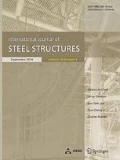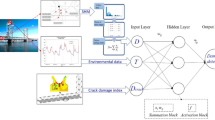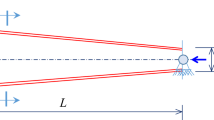Abstract
Cable force monitoring is an important step in cable truss structural health monitoring. Considering cost effectiveness, the accuracy and quality of safety assessments depend primarily on the usage of reasonable cable monitoring programs. Many monitoring methods have been proposed to design the cable truss structure. The emergence of artificial neural network (ANN) models has resulted in improved predictive abilities. In this study, an ANN-based model is used to estimate parameter changes in static and prestress loss tests during the construction of a cable truss. The finite element model data of 243 cases are analysed by ANSYS and MATLAB. Analysis results indicate the excellent prediction performance as well as high accuracy and generalization of the proposed ANN-based model. Furthermore, the successfully trained ANN-based model is used to predict new cases. As an alternative to finite element analysis and physical test, the proposed model can guide the static loading of the spoke cable truss structure and thus allow the safe usage of the structure during service.





























Similar content being viewed by others
References
Bakhary, N., Hao, H., & Deeks, A. J. (2007). Damage detection using artificial neural network with consideration of uncertainties. Engineering Structures, 29(11), 2806–2815
Beale M, Hagan M, Demuth H. MATLAB Deep Learning Toolbox™ User’s Guide: PDF Documentation for Release R2019a. The MathWorks Inc, 2019.
Belenja E I. Prestressed load-bearing metal structures. Mir, 1977.
Chen, M. (2013). Principles and examples of MATLAB neural network [M]. (pp. 4–165). Tsinghua University Press.
Chen, Z. H., Wu, Y. J., Yin, Y., et al. (2010). Formulation and application of multi-node sliding cable element for the analysis of Suspen-Dome structures. Finite Elements in Analysis and Design, 46(9), 743–750
Gomes, H. M., Awruch, A. M., & Lopes, P. A. M. (2011). Reliability based optimization of laminated composite structures using genetic algorithms and Artificial Neural Networks. Structural Safety, 33(3), 186–195
Hashemi, S. S., Sadeghi, K., Fazeli, A., et al. (2019). Predicting the Weight of the Steel Moment-Resisting Frame Structures Using Artificial Neural Networks. International Journal of Steel Structures, 19(1), 168–180
Khoa, N. L. D., Alamdari, M. M., Rakotoarivelo, T., et al. (2018). Structural health monitoring using machine learning techniques and domain knowledge based features[M]//Human and Machine Learning. (pp. 409–435). Springer.
Kim, B. H., & Park, T. (2007). Estimation of cable tension force using the frequency-based system identification method. Journal of Sound and Vibration, 304(3–5), 660–676
Krishnan, S. (2020). Structural design and behavior of prestressed cable domes. Engineering Structures. https://doi.org/10.1016/j.engstruct.2020.110294
Kurian B, Liyanapathirana R. (2020) Machine Learning Techniques for Structural Health Monitoring[C]//Proceedings of the 13th International Conference on Damage Assessment of Structures. Springer, Singapore, pp. 3–24.
Li, S., Wei, S., Bao, Y., et al. (2018). Condition assessment of cables by pattern recognition of vehicle-induced cable tension ratio. Engineering Structures, 155, 1–15
Liu, X., Zhan, X., Zhang, A., et al. (2017). Random imperfection method for stability analysis of a suspended dome[J]. International Journal of Steel Structures, 17(1), 91–103
Liu, Z. S., Han, Z. B., He, J., et al. (2018). Sensitivity test and reliability evaluation of cable relaxation of spoke cable truss. Journal of Tongji University (natural Science Edition), 47, 07 (in Chinese).
Liu, Z. S., Wang, J. C., Han, Z. B., et al. (2019). Sensitivity test and reliability evaluation of length error of cable truss with spokes. Journal of Tianjin University (natural Science and Engineering Technology Edition), 52(S2), 23–30 (in Chinese).
Magnel, G. (1950). Prestressed steel structures. The Structural Engineer, 28(11), 285–295
Mehrabi, A. B., & Tabatabai, H. (1998). Unified finite difference formulation for free vibration of cables. Journal of Structural Engineering, 124(11), 1313–1322
Rizzo, F., & Caracoglia, L. (2020). Artificial Neural Network model to predict the flutter velocity of suspension bridges. Computers and Structures, 233, 106236
Roy, K., Lau, H. H., Ting, T. C. H., et al. (2020). Flexural capacity of gapped built-up cold-formed steel channel sections including web stiffeners. Journal of Constructional Steel Research, 172, 106154
Roy, K., Lau, H. H., Ting, T. C. H., et al. (2021). Flexural behaviour of back-to-back built-up cold-formed steel channel beams: Experiments and finite element modelling[C]//Structures. Elsevier, 29, 235–253
Roy, K., Mohammadjani, C., & Lim, J. B. P. (2019b). Experimental and numerical investigation into the behaviour of face-to-face built-up cold-formed steel channel sections under compression. Thin-Walled Structures, 134, 291–309
Roy, K., Ting, T. C. H., Lau, H. H., et al. (2018a). Nonlinear behavior of axially loaded back-to-back built-up cold-formed steel un-lipped channel sections. Steel and Composite Structures, 28(2), 233–250
Roy, K., Ting, T. C. H., Lau, H. H., et al. (2018b). Nonlinear behaviour of back-to-back gapped built-up cold-formed steel channel sections under compression. Journal of Constructional Steel Research, 147, 257–276
Roy, K., Ting, T. C. H., Lau, H. H., et al. (2018c). Effect of thickness on the behaviour of axially loaded back-to-back cold-formed steel built-up channel sections - Experimental and numerical investigation. Structure. https://doi.org/10.1016/j.istruc.2018.09.009
Roy, K., Ting, T. C. H., Lau, H. H., et al. (2019). Experimental and numerical investigations on the axial capacity of cold-formed steel built-up box sections. Journal of Constructional Steel Research, 160, 411–427
Russell, J. C., & Lardner, T. J. (1998). Experimental determination of frequencies and tension for elastic cables. Journal of Engineering Mechanics, 124(10), 1067–1072
Sychterz, A. C., & Smith, I. F. C. (2018). Using dynamic measurements to detect and locate ruptured cables on a tensegrity structure. Engineering Structures, 173, 631–642. https://doi.org/10.1016/j.engstruct.2018.06.083
Ting, T. C. H., Roy, K., Lau, H. H., et al. (2018). Effect of screw spacing on behavior of axially loaded back-to-back cold-formed steel built-up channel sections. Advances in Structural Engineering, 21(3), 474–487
Wu, X., Ghaboussi, J., & Garrett, J. H., Jr. (1992). Use of neural networks in detection of structural damage. Computers and Structures, 42(4), 649–659
Zarbaf, S. E. H. A. M., Norouzi, M., Allemang, R., et al. (2018). Vibration-based cable condition assessment: A novel application of neural networks. Engineering Structures, 177, 291–305
Acknowledgements
This work was supported by the Beijing Natural Science Foundation (No. 8202001). The support is gratefully acknowledged.
Author information
Authors and Affiliations
Corresponding author
Ethics declarations
Conflict of interests
The author(s) declared no potential conflicts of interest with respect to the research, authorship, and publication of this article.
Additional information
Publisher's Note
Springer Nature remains neutral with regard to jurisdictional claims in published maps and institutional affiliations.
Rights and permissions
About this article
Cite this article
Liu, Z., Jiang, A., Shao, W. et al. Artificial-Neural-Network-Based Mechanical Simulation Prediction Method for Wheel-Spoke Cable Truss Construction. Int J Steel Struct 21, 1032–1052 (2021). https://doi.org/10.1007/s13296-021-00488-9
Received:
Accepted:
Published:
Issue Date:
DOI: https://doi.org/10.1007/s13296-021-00488-9




